The Victorian era revolutionized how you celebrate Valentine's Day. Mass-produced cards emerged, showcasing intricate designs and a range of sentiments from romantic to humorous. The introduction of the postal system allowed for anonymous exchanges, transforming card-giving into a cherished tradition. Queen Victoria's personal connections influenced the romantic imagery found on cards today, highlighting the era's enduring impact. If you're curious about the unique traditions and practices that developed, there's much more to explore.
Key Takeaways
- The Victorian era popularized Valentine's Day through the mass production of intricately designed cards, making them widely accessible for romantic expression.
- Esther Howland, known as the Mother of the American Valentine, contributed to the creation of elaborate card designs that influenced modern aesthetics.
- The introduction of the Uniform Penny Post allowed for anonymous sending of valentines, enhancing the tradition of exchanging romantic tokens.
- Vinegar valentines, featuring humorous or insulting messages, reflected societal attitudes and showcased the diverse emotional spectrum of card-giving during this period.
- Queen Victoria's personal connections emphasized courtship and romance in card-giving, shaping enduring traditions of love and gift exchange in contemporary celebrations.
The Origins of Valentine's Day: From Roman Roots to Victorian Celebrations

While many people celebrate Valentine's Day with flowers and chocolates today, its origins trace back to the ancient Roman festival of Lupercalia, held on February 15. This festival involved rituals designed to pair men and women, setting the stage for romantic connections.
The day became linked with Saint Valentine, a priest who secretly married couples under Roman rule, leading to his martyrdom on February 14 around 270 AD. By the Middle Ages, Valentine's Day was associated with courtly love, popularized by Geoffrey Chaucer's poem.
The Victorian era saw a dramatic rise in the holiday's popularity, thanks to mass-produced cards and advancements in printing technology. These developments transformed Valentine's Day into a significant occasion for expressing love and affection.
The Evolution of Valentine Cards in the Victorian Era
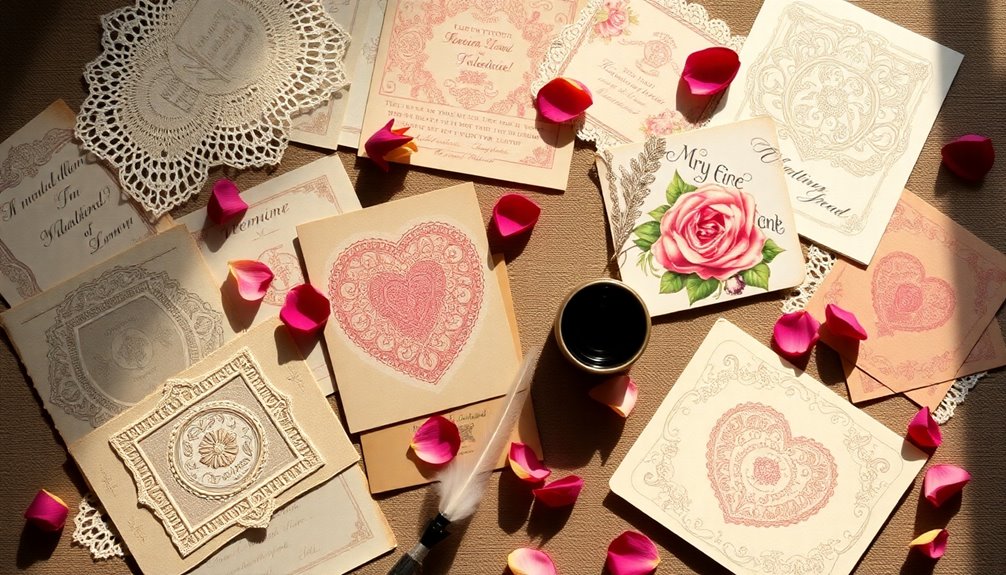
In the Victorian era, you'd see Valentine cards transform dramatically, driven by commercialization and creativity.
With the rise of mass-produced cards, people began to embrace both sentimental and humorous sentiments, including the infamous vinegar valentines that poked fun at unrequited love.
This blending of artistry and personal expression laid the foundation for how we celebrate love today.
Commercialization of Valentine Cards
As the Victorian era unfolded, the commercialization of Valentine cards transformed the way people expressed affection. With the introduction of the Uniform Penny Post in 1840, sending cards became affordable, skyrocketing from 60,000 valentines in 1836 to over 1.2 million by 1871. Manufacturers like Esther Howland capitalized on advancements in printing, creating intricate designs that captured the romantic spirit of the time.
| Key Elements | Impact |
|---|---|
| Affordable Post | Increased card circulation |
| Elaborate Designs | Attracted more buyers |
| Mass Production | Lowered card prices |
| Rise in Literacy | Expanded audience participation |
The blend of innovation and sentimentality marked a significant shift in how Valentine cards were perceived and cherished.
Anonymity and Vinegar Valentines
During the Victorian era, a surprising number of valentines took a sharp turn from romantic to ruthless with the rise of vinegar valentines.
These cards, designed to insult and offend, became popular, with nearly half of all valentines sent during this time falling into this category. The anonymity provided by the postal system allowed senders to deliver cruel messages without fear of consequences.
This led to extreme reactions from recipients, resulting in fist fights and even court cases. The introduction of the Uniform Penny Post in 1840 made mailing these vinegar valentines more accessible, fueling their mass production.
However, by the late 19th century, the trend shifted back to more sentimental expressions of love, marking the decline of vinegar valentines.
Artistic Innovations and Designs
Valentine cards in the Victorian era blossomed into intricate works of art, enchanting the hearts of those who exchanged them.
With the introduction of paper lace, these Victorian valentines featured delicate, elaborate designs that transformed their aesthetic appeal.
By the mid-19th century, mass production made these artistic treasures widely available, mesmerizing all social classes.
You'd find cards adorned with ribbons and embossed borders, echoing the romantic ideals of love and fidelity.
The Uniform Penny Post, introduced in 1840, allowed you to send valentines for just one penny, further fueling their popularity.
As the valentine industry expanded, companies hired hundreds of women to hand-decorate cards, blending commercial success with heartfelt expression, forever shaping the way we celebrate love today.
The Rise of Vinegar Valentines: A Stinging Alternative
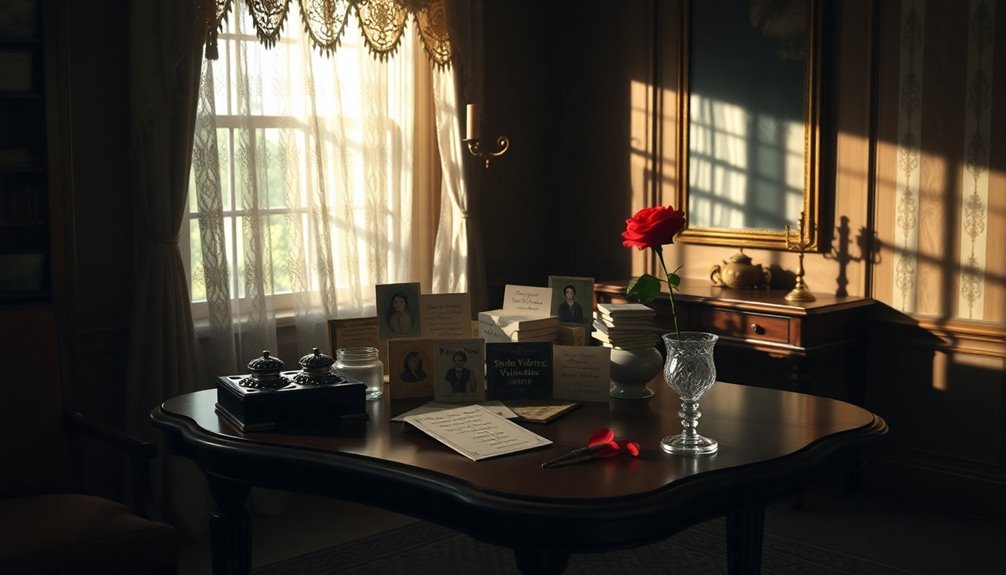
You might be surprised to learn that vinegar valentines became popular in the 1830s and 1840s as a sharp twist on traditional love notes.
These cards, filled with everything from light-hearted insults to harsh critiques, reflected the darker side of Victorian sentiments.
However, public backlash against their crude nature eventually led to their decline, pushing society back toward more romantic expressions of affection.
Origins and Popularity
While love letters traditionally warmed hearts, the Victorian era also birthed a cheeky alternative known as vinegar valentines.
Emerging in the 1830s and 1840s, these sarcastic cards became wildly popular, with nearly half of all valentines sent during that time falling into this category. They were designed to offend, often mocking professions and personal traits through grotesque drawings.
The introduction of the Uniform Penny Post in 1840 made it easier to send these stinging messages for just a penny, fueling their spread.
However, the anonymous nature of vinegar valentines led to extreme reactions, including violence and court cases.
Tone and Content
Emerging from the playful yet harsh social dynamics of the Victorian era, vinegar valentines flipped the notion of romance on its head. These Valentines Day cards, which gained popularity in the 1830s and 1840s, offered a deliberately offensive alternative to the sweet sentiments typically associated with the holiday.
Ranging from gentle jabs to outright aggression, vinegar valentines often mocked professions and personal traits through cruel messages. With caricatures and grotesque drawings, they chided recipients, reflecting societal attitudes toward love that starkly contrasted with modern romantic cards.
The anonymity provided by the postal system allowed senders to release hostility without fear of repercussions, leading to extreme reactions from recipients and ultimately contributing to the decline of this biting form of communication.
Societal Impact and Decline
As vinegar valentines gained traction in Victorian society, they challenged the established norms of romantic expression, stirring both amusement and outrage among the public. These sarcastic cards allowed senders to demean others anonymously, creating a peculiar twist to the tradition of exchanging valentines. However, the backlash was intense; recipients often retaliated, leading to violence and legal disputes.
| Aspect | Vinegar Valentines | Traditional Valentines |
|---|---|---|
| Tone | Sarcastic, Cruel | Sentimental, Affectionate |
| Impact | Social Outrage, Violence | Expressions of Love, Unity |
| Popularity Era | 1830s-1840s | Late 19th Century onwards |
The Impact of Postal Reforms on Valentine Exchanges
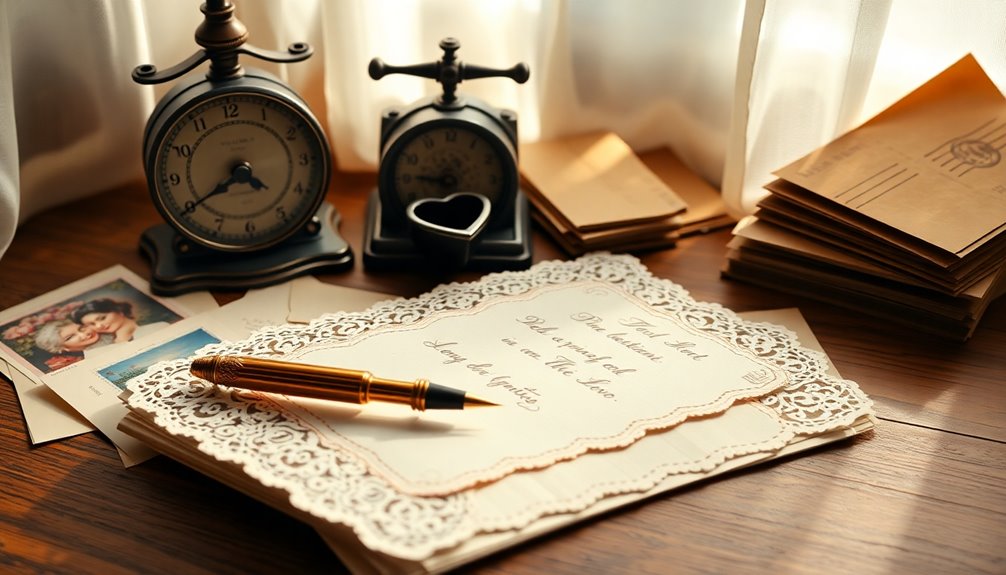
The introduction of the Uniform Penny Post in 1840 revolutionized the way people exchanged Valentine cards, making it accessible for everyone, regardless of their social class.
Suddenly, you could send a heartfelt message for just a penny. This change had a significant impact:
- By 1841, about 400,000 valentines were posted, skyrocketing to 1.2 million by 1871.
- Increased literacy during the Victorian era allowed more individuals to write personalized messages.
- The sheer volume of valentines led to special allowances for refreshments for postmen, reflecting the custom's impact on postal workers.
These reforms democratized the tradition of sending valentines, transforming Valentine's Day into a widespread celebration of affection.
The Role of Manufacturers in Shaping Valentine Traditions
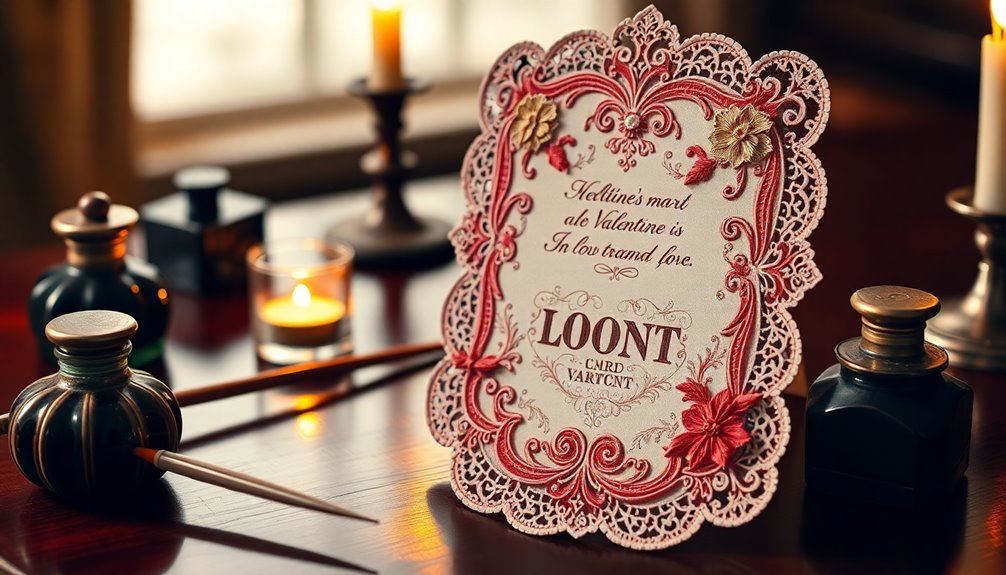
While the rise of the printing press and postal innovations transformed Valentine's Day, manufacturers played a pivotal role in shaping the holiday's traditions. Early pioneers like Esther Howland, known as the Mother of the American Valentine, created intricate card designs that captured hearts. The introduction of the Uniform Penny Post in 1840 facilitated the exchange of 1.2 million valentines in England by 1871. Manufacturers didn't just focus on romantic sentiments; they also tapped into the market for vinegar valentines, showcasing the diverse emotions associated with love.
| Type of Card | Description | Emotional Response |
|---|---|---|
| Romantic Valentine | Delicate, heartfelt messages | Joy, affection |
| Humorous Valentine | Light-hearted, funny notes | Laughter, amusement |
| Insulting Valentine | Vinegar valentines | Surprise, shock |
| Elaborate Designs | Intricate, artistic creations | Awe, admiration |
The Cultural Significance of Sentimental vs. Insulting Valentines
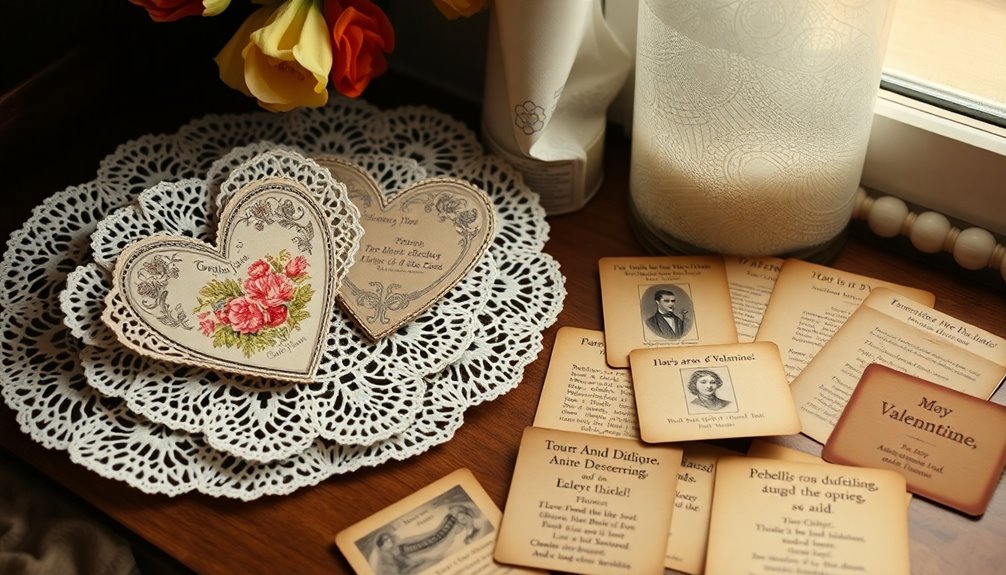
Victorians embraced a wide spectrum of emotions in their Valentine's Day cards, revealing much about their social dynamics and cultural values. While sentimental cards expressed love and affection, vinegar valentines showcased a more aggressive side.
Consider these contrasts:
- Sentimental Cards: Celebrated romance and conveyed heartfelt messages, promoting ideals of love.
- Vinegar Valentines: Aimed to insult, targeting professions or traits, often with anonymity allowing cruel expressions without accountability.
- Cultural Reflection: The proliferation of both types mirrored the evolving tastes of a newly literate society, highlighting complex social interactions.
As vinegar valentines declined in the late 19th century, society shifted back towards more affectionate exchanges, reflecting changing attitudes about love and relationships.
This evolution continues to influence how we celebrate Valentine's Day today.
Queen Victoria's Influence on Valentine's Day Celebrations
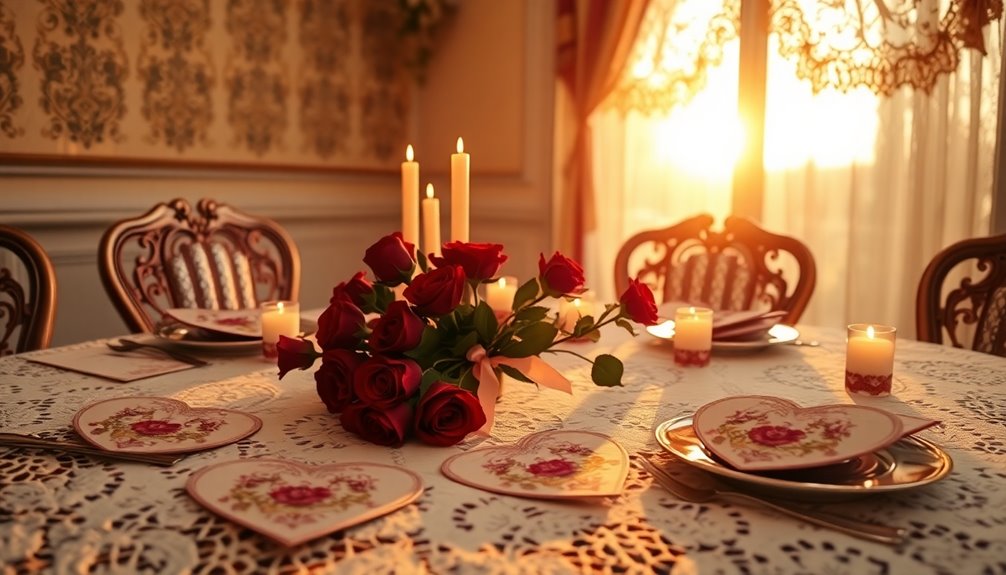
Queen Victoria greatly shaped how Valentine's Day is celebrated today, turning it into a cherished occasion filled with romantic gestures. Her affection for her manservant, John Brown, led her to send innocent and artless Valentine cards, which highlighted the personal connection that made the holiday even more special.
During the Victorian era, the popularity of Valentine's Day surged, thanks in part to the introduction of mass-produced cards that made them accessible to everyone. The emphasis on courtship and romance during this period is reflected in the elaborate designs of the cards.
Victoria's influence transformed Valentine's Day from a simple celebration into an elaborate exchange of tokens of love, solidifying its significance in cultural traditions.
The Legacy of Victorian Valentine's Day in Modern Practices
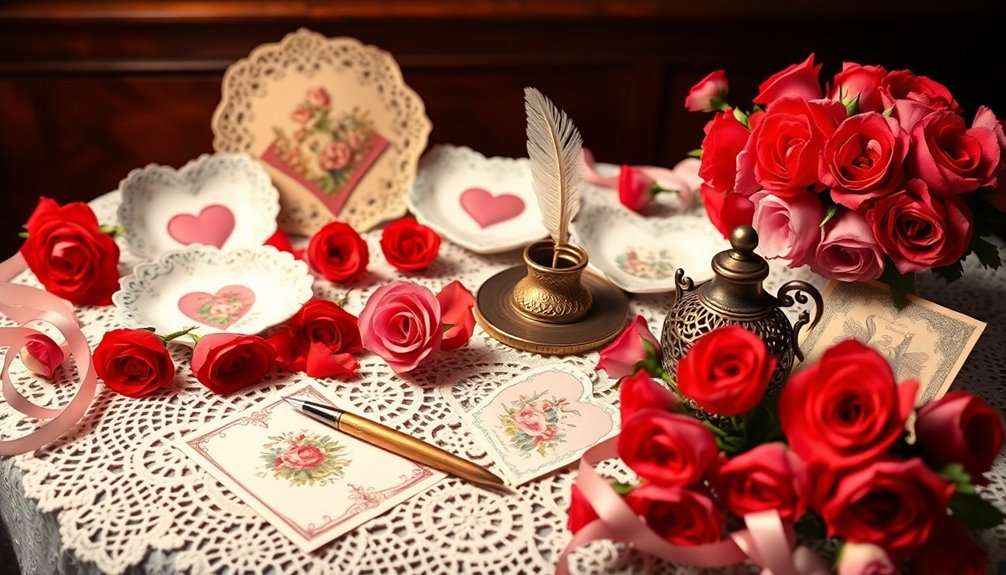
As Valentine's Day celebrations continue to flourish today, the legacy of the Victorian era remains evident in how people express their affection.
You can see this influence in several modern practices:
- Greeting Cards: The mass production of Valentine's Day cards originated in the Victorian era, making them a staple for expressing love across social classes.
- Gift-Giving: The tradition of giving chocolates and flowers, rooted in Victorian customs, has expanded to include personalized gifts that reflect individual relationships.
- Symbolism: The language of flowers, popularized during this time, still shapes the gifts you choose—like red roses symbolizing deep love.
These timeless traditions not only highlight the romantic spirit of Valentine's Day but also connect you to a rich historical legacy.
Anonymity and Its Effects on Valentine Card Exchanges
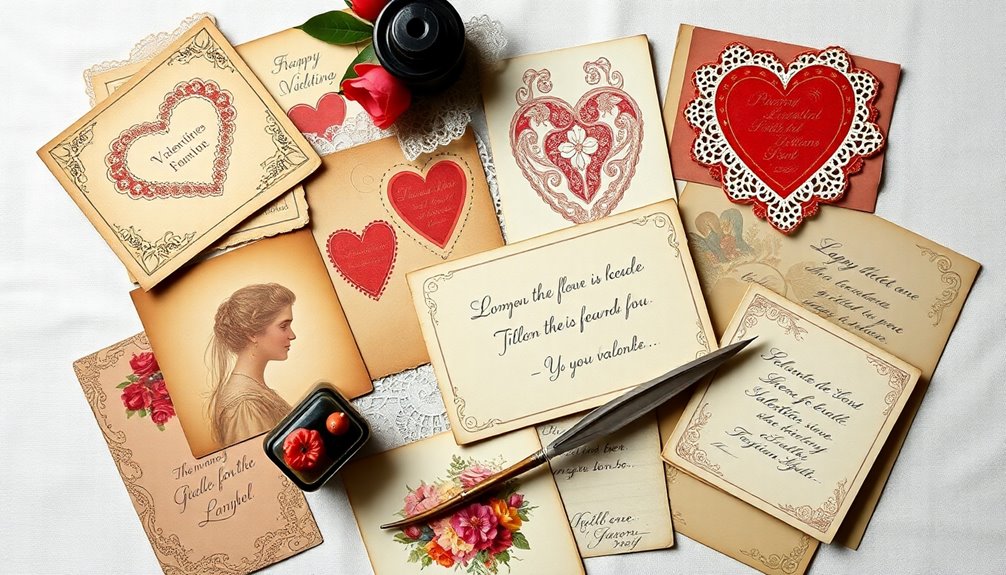
While the introduction of the postal system in the Victorian era revolutionized the way people exchanged valentines, it also opened the door to a darker side of card-giving. The anonymity of sending valentine cards led to the rise of vinegar valentines, which aimed to insult rather than express affection. Recipients often bore the postage costs, creating a financial burden that discouraged retaliation. This lack of accountability allowed senders to deliver cruel messages without consequences, leading to extreme public reactions, including fist fights and court cases.
| Type of Card | Purpose | Social Reaction |
|---|---|---|
| Traditional Valentines | Express affection | Joy and celebration |
| Vinegar Valentines | Insult or offend | Anger and conflict |
| Anonymous Sending | Avoid accountability | Fear and retaliation |
| Sentimental Shift | Return to genuine expressions | Relief and appreciation |
Frequently Asked Questions
What Is the Victorian Mean Spirited Valentine's?
Victorian mean-spirited valentines, often called vinegar valentines, were harsh cards designed to insult rather than express love.
You'd find cruel messages and exaggerated caricatures targeting specific traits or professions. Nearly half of the valentines sent during that time were vinegar valentines, reflecting society's darker side.
The anonymity of the postal system let senders deliver these jabs without facing consequences, leading to extreme reactions, from hurt feelings to public outrage.
What Are the Origins of Modern Valentine's Day?
Modern Valentine's Day traces its origins back to medieval love celebrations, particularly linked to St. Valentine.
You might recognize Geoffrey Chaucer's poetry as a key influence that romanticized this day.
Over time, the holiday evolved, especially in the 19th century when sending greeting cards became popular.
As you exchange cards today, remember that these traditions stem from centuries of love expressions, transforming into the commercialized celebration you know and enjoy now.
What Is the Victorian Era Term for a Mean and Comically Mocking Valentine's Day Card?
Did you know nearly half of the valentines sent during the Victorian era were actually mean-spirited?
Those cards were called "vinegar valentines," and they served as a humorous, albeit cruel, alternative to the traditional romantic cards.
You'd find these cards filled with mocking sentiments and caricatures, aimed at insulting various individuals.
The anonymity of the senders allowed for bold insults, leading to some intense reactions, like fist fights and even court cases!
What Is the History of the Victorian Valentine Cards?
Victorian valentine cards became popular in the mid-19th century, thanks to the introduction of the Uniform Penny Post, which made mailing affordable.
You'd find cards adorned with intricate designs, including paper lace and beautiful illustrations.
By the 1840s, millions of valentines were exchanged, showcasing heartfelt messages and sentimental verses.
This era's romantic spirit fueled a booming industry, allowing both handmade and mass-produced cards to flourish, making the tradition of sending valentines a widespread custom.
Conclusion
Valentine's Day, once a simple Roman celebration, transformed into a complex Victorian tradition, blending sweet sentiments with sharp-tongued humor. As you exchange heartfelt cards today, remember the influence of vinegar valentines lurking beneath the surface. The joy of love dances alongside the sting of rejection, reminding us that both tenderness and sarcasm have their place in our hearts. In this juxtaposition, you find a richer understanding of love—one that embraces both the sweet and the sour.









